Mapping Knowledge in the Economic Areas of Green Building Using Scientometric Analysis
Abstract
1. Introduction
2. Background
2.1. Green Building
2.2. Green Building Economics
3. Research Method
3.1. Science Mapping Tool Selection
3.2. Data Collection
4. Analysis and Results
4.1. Document Co-Citation Analysis
4.2. Keyword Co-Occurrence Analysis
4.3. Cluster Identification and Interpretation
4.4. Citation Burst Detection
5. Discussion
5.1. GBE Knowledge Map
5.2. Limitations and Recommendations
- Greater effort in providing empirical evidence on the controversial issue of whether the initial or life cycle cost of green building is higher than its conventional counterpart should be made. More work needs to be done on understanding the green building cost and its components because of their large influence on the initial decision making of a building in terms of technology and design [106]. Additionally, further study on the influence of advanced green building designs and technologies on cost, and the strategies to optimize sustainability under the limited green building budget should be encouraged.
- GBE publications should play a bigger role in illustrating how much benefit green building produces and how to achieve green building. The direct benefits of green building, including energy efficiency, water efficiency, and waste production appear to be central to research efforts [49]. However, focusing solely on the evaluation of direct benefits is insufficient for fully fulfilling green building’s potential. Existing studies of the indirect benefits of green building including comfort level, employee productivity, health, retention, and recruiting are less than adequate. Consequently, more studies are necessary to address and quantify the indirect benefits [70], as well as improving the willingness to pay for green building.
- Given the significance of green technologies, more work is needed to fully understand the cost and the benefit of existing technologies in green building practice. The economic issues related to the key factors for technology adoption should be further explored. Additionally, greater research effort should be made on strategies of applying green technologies under different budget limitations and conditions.
- Further research is required in resolving conflicts of interest in green building management. The building contractors’ perspective is clearly different from that of the owners. The benefits of introducing an energy efficient design into a building, for example, are incommensurate with the increase in property value [71]. Economic theories such as game theory and agent cost need to be better cooperated with GBE studies, as well as strategies for dealing with conflicts of interest between stakeholders [107].
- Because effective policies could align incentives to enhance the demand for green building, more research effort should be made on the green building industry level. Green building policies are designed to address market efficiency and this requires the fully understanding of the cost premium and incremental benefits involved. Therefore, future research is encourage to analyzing the existing green building policies and corresponding market conditions in different regions to provide the empirical evidence for effective policymaking. Greater attention should also be paid to analyzing the resale or rental asset value of green building, as well as examining green building market volatility.
6. Conclusions
Author Contributions
Funding
Conflicts of Interest
References
- Jiang, S.; Wang, N.; Wu, J. Combining BIM and ontology to facilitate intelligent green building evaluation. J. Comput. Civ. Eng. 2018, 32, 04018039. [Google Scholar] [CrossRef]
- Darko, A.; Chan, A.P.C.; Huo, X.; Owusu-Manu, D.-G. A scientometric analysis and visualization of global green building research. Build. Environ. 2019, 149, 501–511. [Google Scholar] [CrossRef]
- Zuo, J.; Zhao, Z.-Y. Green building research–current status and future agenda: A review. Renew. Sustain. Energy Rev. 2014, 30, 271–281. [Google Scholar] [CrossRef]
- Wadu Mesthrige, J.; Kwong, H.Y. Criteria and barriers for the application of green building features in Hong Kong. Smart Sustain. Built Environ. 2018, 7, 251–276. [Google Scholar] [CrossRef]
- Yang, J.; Yang, Z. Critical factors affecting the implementation of sustainable housing in Australia. J. Hous. Built Environ. 2015, 30, 275–292. [Google Scholar] [CrossRef]
- Shi, Q.; Zuo, J.; Huang, R.; Huang, J.; Pullen, S. Identifying the critical factors for green construction—An empirical study in China. Habitat Int. 2013, 40, 1–8. [Google Scholar] [CrossRef]
- Shen, W.; Tang, W.; Siripanan, A.; Lei, Z.; Duffield, C.; Hui, F. Understanding the green technical capabilities and barriers to green buildings in developing countries: A case study of Thailand. Sustainability 2018, 10, 3585. [Google Scholar] [CrossRef]
- Dwaikat, L.N.; Ali, K.N. Green buildings cost premium: A review of empirical evidence. Energy Build. 2016, 110, 396–403. [Google Scholar] [CrossRef]
- Russ, N.M.; Hanid, M.; Kho, M.Y. Literature review on green cost premium of sustainable building construction. Int. J. Technol. 2018, 9, 1715–1725. [Google Scholar] [CrossRef]
- Zhang, L.; Wu, J.; Liu, H. Turning green into gold: A review on the economics of green buildings. J. Clean. Prod. 2018, 172, 2234–2245. [Google Scholar] [CrossRef]
- Hammersley, M. On ‘Systematic’ reviews of research literatures: A ‘narrative’ response to Evans & Benefield. Br. Educ. Res. J. 2001, 27, 543–554. [Google Scholar] [CrossRef]
- Korkmaz, S.; Erten, D.; Syal, M.; Potbhare, V. A review of green building movement timelines in developed and developing countries to build an international adoption framework. In Proceedings of the Fifth International Conference on Construction in the 21st Century: Collaboration and Integration in Engineering, Management and Technology, Istanbul, Turkey, 20–22 May 2009. [Google Scholar]
- Xiao, X.; Skitmore, M.; Hu, X. Case-based reasoning and text mining for green building decision making. Energy Procedia 2017, 111, 417–425. [Google Scholar] [CrossRef]
- Ernest, J.; Yanarella Richard, S.; Levine Robert, W.; Lancaster. Research and Solutions: “Green” vs. Sustainability: From Semantics to Enlightenment. Sustain. J. Rec. 2009, 2, 296–302. [Google Scholar] [CrossRef]
- Glavinich, T.E. Contractor’s Guide to Green Building Construction: Management, Project Delivery, Documentation, and Risk Reduction; John Wiley & Sons: Hoboken, NJ, USA, 2008. [Google Scholar] [CrossRef]
- Yudelson, J. The Green Building Revolution; Island Press: Washington, DC, USA, 2010; ISBN 978-1-59726-178-4. [Google Scholar]
- Cole, R.J. Building environmental assessment methods: Redefining intentions and roles. Build. Res. Inf. 2005, 33, 455–467. [Google Scholar] [CrossRef]
- Sartori, I.; Hestnes, A.G. Energy use in the life cycle of conventional and low-energy buildings: A review article. Energy Build. 2007, 39, 249–257. [Google Scholar] [CrossRef]
- Hu, M. Does zero energy building cost more?—An empirical comparison of the construction costs for zero energy education building in United States. Sustain. Cities Soc. 2019, 45, 324–334. [Google Scholar] [CrossRef]
- Scofield, J.H. Do LEED-certified buildings save energy? Not really…. Energy Build. 2009, 41, 1386–1390. [Google Scholar] [CrossRef]
- Kats, G. Green Building Costs and Financial Benefits; Massachusetts Technology Collaborative: Boston, MA, USA, 2003; Available online: http://www.greenspacebuildings.com/wp-content/uploads/2011/05/Kats-Green-Buildings-Cost.pdf (accessed on 3 August 2019).
- Ries, R.; Bilec, M.M.; Gokhan, N.M.; Needy, K.L. The economic benefits of green buildings: A comprehensive case study. Eng. Econ. 2006, 51, 259–295. [Google Scholar] [CrossRef]
- Zhang, X.; Shen, L.; Wu, Y. Green strategy for gaining competitive advantage in housing development: A China study. J. Clean. Prod. 2011, 19, 157–167. [Google Scholar] [CrossRef]
- Newsham, G.R.; Mancini, S.; Birt, B.J. Do LEED-certified buildings save energy? Yes, but…. Energy Build. 2009, 41, 897–905. [Google Scholar] [CrossRef]
- Eichholtz, P.; Kok, N.; Quigley, J.M. The economics of green building. Rev. Econ. Stat. 2013, 95, 50–63. [Google Scholar] [CrossRef]
- Lau, L.C.; Tan, K.T.; Lee, K.T.; Mohamed, A.R. A comparative study on the energy policies in Japan and Malaysia in fulfilling their nations’ obligations towards the Kyoto Protocol. Energy Policy 2009, 37, 4771–4778. [Google Scholar] [CrossRef]
- Nguyen, H.-T.; Skitmore, M.; Gray, M.; Zhang, X.; Olanipekun, A.O. Will green building development take off? An exploratory study of barriers to green building in Vietnam. Resour. Conserv. Recycl. 2017, 127, 8–20. [Google Scholar] [CrossRef]
- Darko, A.; Chan, A.P. Review of barriers to green building adoption. Sustain. Dev. 2017, 25, 167–179. [Google Scholar] [CrossRef]
- Darko, A.; Chan, A.P.C.; Yang, Y.; Shan, M.; He, B.-J.; Gou, Z. Influences of barriers, drivers, and promotion strategies on green building technologies adoption in developing countries: The Ghanaian case. J. Clean. Prod. 2018, 200, 687–703. [Google Scholar] [CrossRef]
- Collins, D.; Junghans, A.; Haugen, T. Green leasing in commercial real estate: The drivers and barriers for owners and tenants of sustainable office buildings. J. Corp. Real Estate 2018, 20, 244–259. [Google Scholar] [CrossRef]
- Chan, A.P.C.; Darko, A.; Olanipekun, A.O.; Ameyaw, E.E. Critical barriers to green building technologies adoption in developing countries: The case of Ghana. J. Clean. Prod. 2018, 172, 1067–1079. [Google Scholar] [CrossRef]
- Kibert, C.J. Green buildings: An overview of progress. Fla. State Univ. J. Land Use Environ. Law 2004, 19, 491–502. [Google Scholar]
- Ofori, G. The Construction Industry: Aspects of Its Economics and Management; NUS Press: Singapore, 1990; ISBN 9971-69-148-5. [Google Scholar]
- Hillebrandt, P.M. The nature of construction economics. In Economic Theory and the Construction Industry; Palgrave Macmillan: London, UK, 1974; pp. 3–8. [Google Scholar] [CrossRef]
- Rakhra, A.S.; Wilson, A.J. Building economics and the economics of building. Build. Econ. 1982, 21, 51–53. [Google Scholar]
- Jing, Y.-Y.; Bai, H.; Wang, J.-J.; Liu, L. Life cycle assessment of a solar combined cooling heating and power system in different operation strategies. Appl. Energy 2012, 92, 843–853. [Google Scholar] [CrossRef]
- Iribarren, D.; Vázquez-Rowe, I.; Rugani, B.; Benetto, E. On the feasibility of using emergy analysis as a source of benchmarking criteria through data envelopment analysis: A case study for wind energy. Energy 2014, 67, 527–537. [Google Scholar] [CrossRef]
- Kosareo, L.; Ries, R. Comparative environmental life cycle assessment of green roofs. Build. Environ. 2007, 42, 2606–2613. [Google Scholar] [CrossRef]
- Zabalza Bribián, I.; Valero Capilla, A.; Aranda Usón, A. Life cycle assessment of building materials: Comparative analysis of energy and environmental impacts and evaluation of the eco-efficiency improvement potential. Build. Environ. 2011, 46, 1133–1140. [Google Scholar] [CrossRef]
- Narayan, P.K.; Narayan, S.; Popp, S. A note on the long-run elasticities from the energy consumption–GDP relationship. Appl. Energy 2010, 87, 1054–1057. [Google Scholar] [CrossRef]
- Narayan, S.; Doytch, N. An investigation of renewable and non-renewable energy consumption and economic growth nexus using industrial and residential energy consumption. Energy Econ. 2017, 68, 160–176. [Google Scholar] [CrossRef]
- Chen, C.; Ibekwe-SanJuan, F.; Hou, J. The structure and dynamics of cocitation clusters: A multiple-perspective cocitation analysis. J. Am. Soc. Inf. Sci. Technol. 2010, 61, 1386–1409. [Google Scholar] [CrossRef]
- Börner, K.J.M.P. Atlas of Science: Visualizing What We Know; Cambridge: Boston, MA, USA, 2010. [Google Scholar] [CrossRef][Green Version]
- Li, X.; Wu, P.; Shen, G.Q.; Wang, X.; Teng, Y. Mapping the knowledge domains of Building Information Modeling (BIM): A bibliometric approach. Autom. Constr. 2017, 84, 195–206. [Google Scholar] [CrossRef]
- Chaomei, C. Science mapping: A systematic review of the literature. J. Data Inf. Sci. 2017, 2, 1–40. [Google Scholar] [CrossRef]
- Cobo, M.J.; López-Herrera, A.G.; Herrera-Viedma, E.; Herrera, F. Science mapping software tools: Review, analysis, and cooperative study among tools. J. Am. Soc. Inf. Sci. Technol. Banner 2011, 62, 1382–1402. [Google Scholar] [CrossRef]
- Sedighi, M.; Jalalimanesh, A. Mapping research trends in the field of knowledge management. Malays. J. Libr. Inf. Sci. 2017, 19, 71–85. [Google Scholar]
- Aghaei Chadegani, A.; Salehi, H.; Yunus, M.; Farhadi, H.; Fooladi, M.; Farhadi, M.; Ale Ebrahim, N.J. A comparison between two main academic literature collections: Web of Science and Scopus databases. Asian Soc. Sci. 2013, 9, 18–26. [Google Scholar] [CrossRef]
- Olubunmi, O.A.; Xia, P.B.; Skitmore, M. Green building incentives: A review. Renew. Sustain. Energy Rev. 2016, 59, 1611–1621. [Google Scholar] [CrossRef]
- Chegut, A.; Eichholtz, P.; Kok, N. Supply, demand and the value of green buildings. Urban Stud. 2013, 51, 22–43. [Google Scholar] [CrossRef]
- Fan, K.; Chan, E.H.; Qian, Q.K. Transaction costs (TCs) in green building (GB) incentive schemes: Gross Floor Area (GFA) Concession Scheme in Hong Kong. Energy Policy 2018, 119, 563–573. [Google Scholar] [CrossRef]
- Kahn, M.E.; Kok, N. The capitalization of green labels in the California housing market. Reg. Sci. Urban Econ. 2014, 47, 25–34. [Google Scholar] [CrossRef]
- Lützkendorf, T.; Lorenz, D. Sustainable property investment: Valuing sustainable buildings through property performance assessment. Build. Res. Inf. 2005, 33, 212–234. [Google Scholar] [CrossRef]
- Von Paumgartten, P. The business case for high performance green buildings: Sustainability and its financial impact. J. Facil. Manag. 2003, 2, 26–34. [Google Scholar] [CrossRef]
- Darko, A.; Chan, A.P.C. Critical analysis of green building research trend in construction journals. Habitat Int. 2016, 57, 53–63. [Google Scholar] [CrossRef]
- Hosseini, M.R.; Martek, I.; Zavadskas, E.K.; Aibinu, A.A.; Arashpour, M.; Chileshe, N. Critical evaluation of off-site construction research: A Scientometric analysis. Autom. Constr. 2018, 87, 235–247. [Google Scholar] [CrossRef]
- Santos, R.; Costa, A.A.; Grilo, A. Bibliometric analysis and review of Building Information Modelling literature published between 2005 and 2015. Autom. Constr. 2017, 80, 118–136. [Google Scholar] [CrossRef]
- Robichaud, L.B.; Anantatmula, V.S. Greening project management practices for sustainable construction. J. Manag. Eng. 2010, 27, 48–57. [Google Scholar] [CrossRef]
- Ding, G.K.C. Sustainable construction—The role of environmental assessment tools. J. Environ. Manag. 2008, 86, 451–464. [Google Scholar] [CrossRef]
- Häkkinen, T.; Belloni, K. Barriers and drivers for sustainable building. Build. Res. Inf. 2011, 39, 239–255. [Google Scholar] [CrossRef]
- Hwang, B.-G.; Tan, J.S. Green building project management: Obstacles and solutions for sustainable development. Sustain. Dev. 2012, 20, 335–349. [Google Scholar] [CrossRef]
- Zhang, X.; Platten, A.; Shen, L. Green property development practice in China: Costs and barriers. Build. Environ. 2011, 46, 2153–2160. [Google Scholar] [CrossRef]
- Eichholtz, P.; Kok, N.; Quigley, J.M. Doing well by doing good? Green office buildings. Am. Econ. Rev. 2010, 100, 2492–2509. [Google Scholar] [CrossRef]
- Fuerst, F.; McAllister, P. Green noise or green value? Measuring the effects of environmental certification on office values. Real Estate Econ. 2011, 39, 45–69. [Google Scholar] [CrossRef]
- Fang, Y.; Yin, J.; Wu, B. Climate change and tourism: A scientometric analysis using CiteSpace. J. Sustain. Tour. 2018, 26, 108–126. [Google Scholar] [CrossRef]
- Hu, J.; Zhang, Y. Research patterns and trends of Recommendation System in China using co-word analysis. Inf. Process. Manag. 2015, 51, 329–339. [Google Scholar] [CrossRef]
- Ortiz, O.; Castells, F.; Sonnemann, G. Sustainability in the construction industry: A review of recent developments based on LCA. Constr. Build. Mater. 2009, 23, 28–39. [Google Scholar] [CrossRef]
- Kneifel, J. Life-cycle carbon and cost analysis of energy efficiency measures in new commercial buildings. Energy Build. 2010, 42, 333–340. [Google Scholar] [CrossRef]
- Lee, C.; Hong, T.; Lee, G.; Jeong, J. Life-cycle cost analysis on glass type of high-rise buildings for increasing energy efficiency and reducing CO2 emissions in Korea. J. Constr. Eng. Manag. 2011, 138, 897–904. [Google Scholar] [CrossRef]
- MacNaughton, P.; Cao, X.; Buonocore, J.; Cedeno-Laurent, J.; Spengler, J.; Bernstein, A.; Allen, J. Energy savings, emission reductions, and health co-benefits of the green building movement. J. Expo. Sci. Environ. Epidemiol. 2018, 28, 307–318. [Google Scholar] [CrossRef]
- Manganelli, B.; Morano, P.; Tajani, F.; Salvo, F. Affordability assessment of energy-efficient building construction in Italy. Sustainability 2019, 11, 249. [Google Scholar] [CrossRef]
- Wang, W.; Zmeureanu, R.; Rivard, H. Applying multi-objective genetic algorithms in green building design optimization. Build. Environ. 2005, 40, 1512–1525. [Google Scholar] [CrossRef]
- Lam, P.T.I.; Chan, E.H.W.; Poon, C.S.; Chau, C.K.; Chun, K.P. Factors affecting the implementation of green specifications in construction. J. Environ. Manag. 2010, 91, 654–661. [Google Scholar] [CrossRef]
- Cajias, M.; Piazolo, D. Green performs better: Energy efficiency and financial return on buildings. J. Corp. Real Estate 2013, 15, 53–72. [Google Scholar] [CrossRef]
- Ma, Y.; Kelman, A.; Daly, A.; Borrelli, F. Predictive control for energy efficient buildings with thermal storage: Modeling, stimulation, and experiments. IEEE Control Syst. Mag. 2012, 32, 44–64. [Google Scholar] [CrossRef]
- Komnitsas, K.A. Potential of geopolymer technology towards green buildings and sustainable cities. Procedia Eng. 2011, 21, 1023–1032. [Google Scholar] [CrossRef]
- Jaillon, L.; Poon, C.S.; Chiang, Y.H. Quantifying the waste reduction potential of using prefabrication in building construction in Hong Kong. Waste Manag. 2009, 29, 309–320. [Google Scholar] [CrossRef]
- Kamel, E.; Memari, A.M. Review of BIM’s application in energy simulation: Tools, issues, and solutions. Autom. Constr. 2019, 97, 164–180. [Google Scholar] [CrossRef]
- Sailor, D.J. A green roof model for building energy simulation programs. Energy Build. 2008, 40, 1466–1478. [Google Scholar] [CrossRef]
- Castro-Lacouture, D.; Sefair, J.A.; Flórez, L.; Medaglia, A.L. Optimization model for the selection of materials using a LEED-based green building rating system in Colombia. Build. Environ. 2009, 44, 1162–1170. [Google Scholar] [CrossRef]
- Wang, W.; Rivard, H.; Zmeureanu, R. Floor shape optimization for green building design. Adv. Eng. Inf. 2006, 20, 363–378. [Google Scholar] [CrossRef]
- Dagdougui, H.; Minciardi, R.; Ouammi, A.; Robba, M.; Sacile, R. Modeling and optimization of a hybrid system for the energy supply of a “Green” building. Energy Convers. Manag. 2012, 64, 351–363. [Google Scholar] [CrossRef]
- Zhai, X.Q.; Wang, R.Z.; Dai, Y.J.; Wu, J.Y.; Xu, Y.X.; Ma, Q. Solar integrated energy system for a green building. Energy Build. 2007, 39, 985–993. [Google Scholar] [CrossRef]
- Dunning, T. Accurate methods for the statistics of surprise and coincidence. Comput. Linguist. 1993, 19, 61–74. [Google Scholar]
- Salton, G.; Wong, A.; Yang, C.S. A vector space model for automatic indexing. Commun. ACM 1975, 18, 613–620. [Google Scholar] [CrossRef]
- He, Q.; Wang, G.; Luo, L.; Shi, Q.; Xie, J.; Meng, X. Mapping the managerial areas of Building Information Modeling (BIM) using scientometric analysis. Int. J. Proj. Manag. 2017, 35, 670–685. [Google Scholar] [CrossRef]
- Kaufman, L.; Rousseeuw, P.J. Finding Groups in Data: An Introduction to Cluster; John Wiley & Sons: Hoboken, NJ, USA, 2009; Volume 344. [Google Scholar] [CrossRef]
- Sandström, U.G. Green infrastructure planning in urban Sweden. Plan. Pract. Res. 2002, 17, 373–385. [Google Scholar] [CrossRef]
- Abdulmalek, F.A.; Rajgopal, J. Analyzing the benefits of lean manufacturing and value stream mapping via simulation: A process sector case study. Int. J. Prod. Econ. 2007, 107, 223–236. [Google Scholar] [CrossRef]
- Chen, C. CiteSpace II: Detecting and visualizing emerging trends and transient patterns in scientific literature. J. Am. Soc. Inf. Sci. Technol. 2006, 57, 359–377. [Google Scholar] [CrossRef]
- Jin, Y.; Ji, S.; Li, X.; Yu, J. A scientometric review of hotspots and emerging trends in additive manufacturing. J. Manuf. Technol. Manag. 2017, 28, 18–38. [Google Scholar] [CrossRef]
- Chen, C.; Hu, Z.; Liu, S.; Tseng, H. Emerging trends in regenerative medicine: A scientometric analysis in CiteSpace. Exp. Opin. Biol. Ther. 2012, 12, 593–608. [Google Scholar] [CrossRef]
- Miller, N.; Spivey, J.; Florance, A. Does green pay off? J. Real Estate Portf. Manag. 2008, 14, 385–399. [Google Scholar]
- Ali, H.H.; Al Nsairat, S.F. Developing a green building assessment tool for developing countries—Case of Jordan. Build. Environ. 2009, 44, 1053–1064. [Google Scholar] [CrossRef]
- Haapio, A.; Viitaniemi, P. A critical review of building environmental assessment tools. Environ. Impact Assess. Rev. 2008, 28, 469–482. [Google Scholar] [CrossRef]
- Chan, E.H.W.; Qian, Q.K.; Lam, P.T.I. The market for green building in developed Asian cities—the perspectives of building designers. Energy Policy 2009, 37, 3061–3070. [Google Scholar] [CrossRef]
- Hwang, B.-G.; Ng, W.J. Project management knowledge and skills for green construction: Overcoming challenges. Int. J. Proj. Manag. 2013, 31, 272–284. [Google Scholar] [CrossRef]
- Lutzenhiser, L. 19 Greening the Economy from the Bottom up? Lessons in Consumption from the Energy Case. Read. Econ. Soc. 2002, 19, 345–356. [Google Scholar]
- Zuo, J.; Pullen, S.; Rameezdeen, R.; Bennetts, H.; Wang, Y.; Mao, G.; Duan, H. Green building evaluation from a life-cycle perspective in Australia: A critical review. Renew. Sustain. Energy Rev. 2017, 70, 358–368. [Google Scholar] [CrossRef]
- Kibert, C.J. Establishing principles and a model for sustainable construction. In Proceedings of the First International Conference on Sustainable Construction, Tampa, FL, USA, 6–9 November 1994. [Google Scholar]
- Gilg, A.; Barr, S.; Ford, N.J.F. Green consumption or sustainable lifestyles? Identif. Sustain. Consum. 2005, 37, 481–504. [Google Scholar]
- Zuo, J.; Jin, X.-H.; Flynn, L. Social sustainability in construction–an explorative study. Int. J. Constr. Manag. 2012, 12, 51–63. [Google Scholar] [CrossRef]
- Singh, B.; Garg, S.K.; Sharma, S.K. Value stream mapping: Literature review and implications for Indian industry. Int. J. Adv. Manuf. Technol. 2011, 53, 799–809. [Google Scholar] [CrossRef]
- Gou, Z.; Xie, X. Evolving green building: Triple bottom line or regenerative design? J. Clean. Produc. 2017, 153, 600–607. [Google Scholar] [CrossRef]
- Petrovic-Lazarevic, S. Economics. The development of corporate social responsibility in the Australian construction industry. Constr. Manag. Econ. 2008, 26, 93–101. [Google Scholar] [CrossRef]
- Xiao, X.; Wang, F.; Li, H.; Skitmore, M. Modelling the stochastic dependence underlying construction cost and duration. J. Civ. Eng. Manag. 2018, 24, 444–456. [Google Scholar] [CrossRef]
- Matisoff, D.C.; Noonan, D.S.; Flowers, M.E. Policy monitor—Green buildings: Economics and policies. Rev. Environ. Econ. Policy 2016, 10, 329–346. [Google Scholar] [CrossRef]

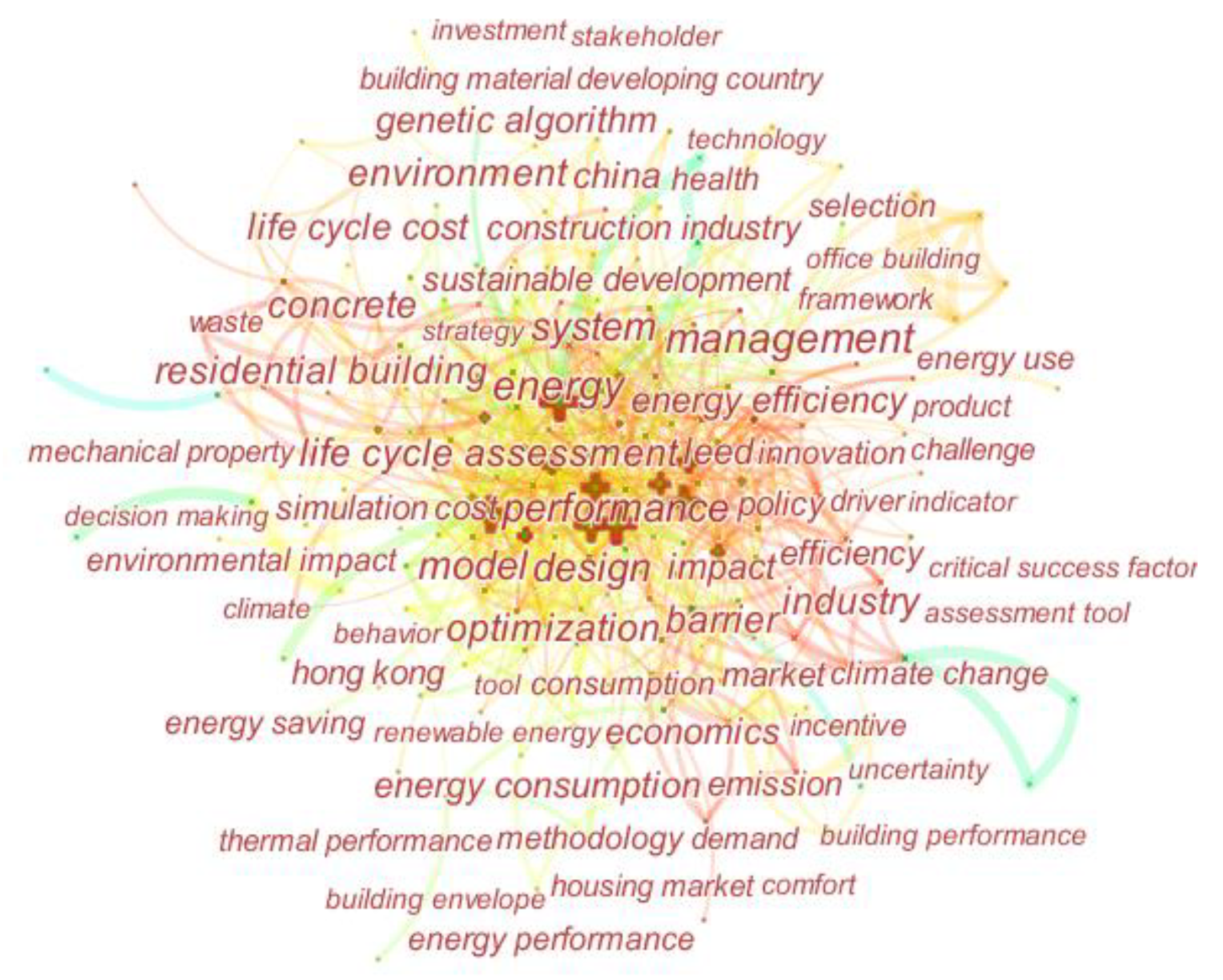
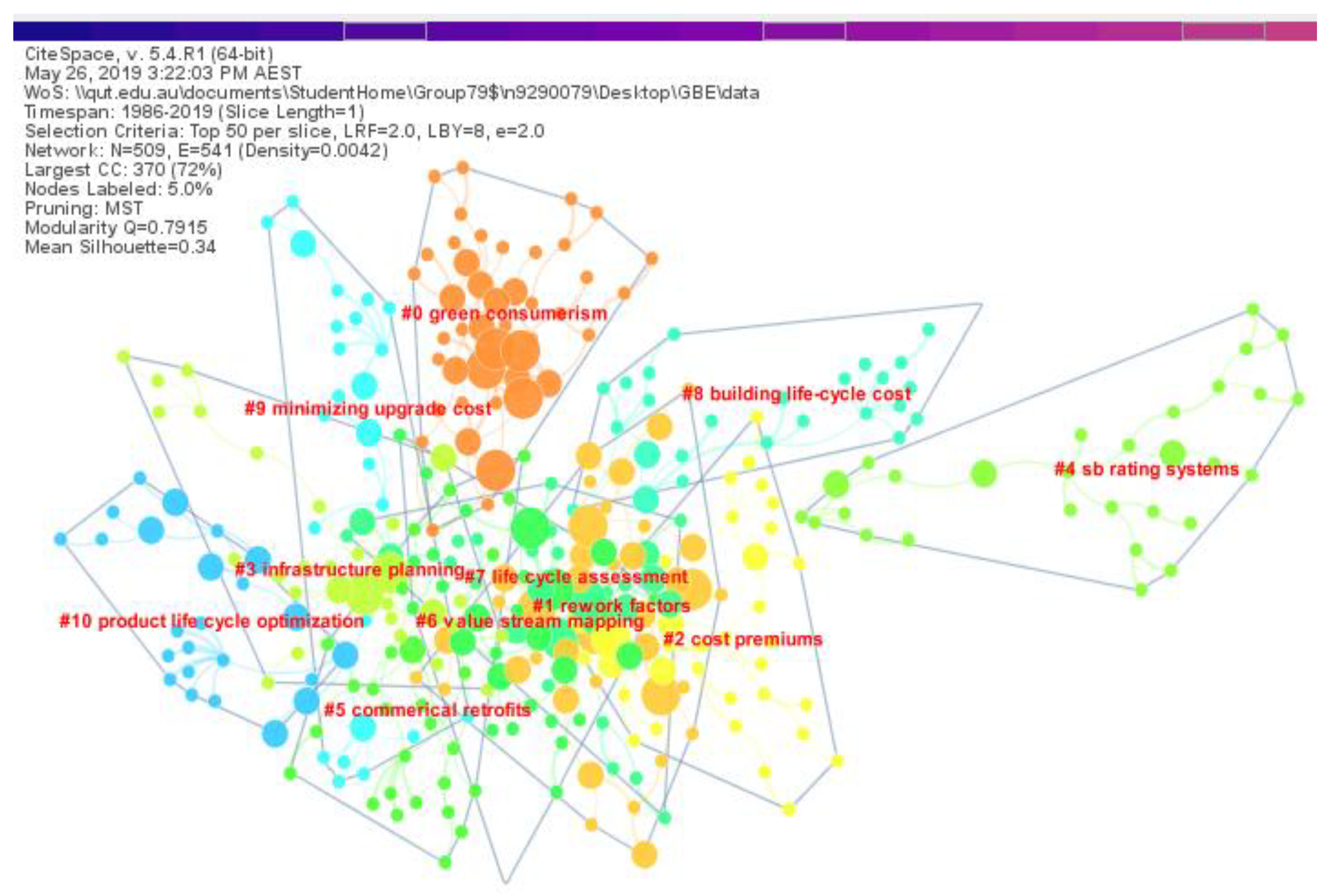
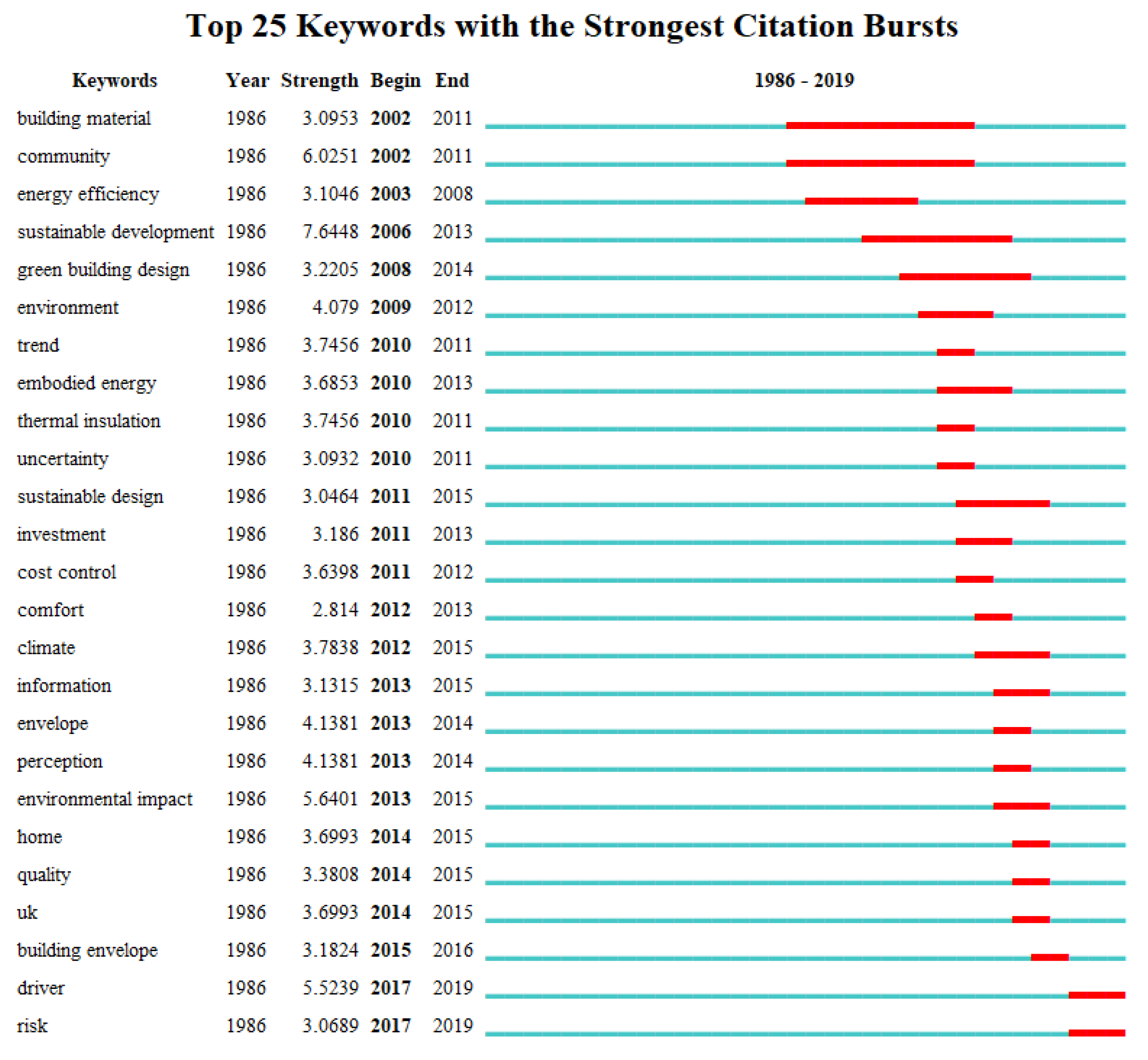
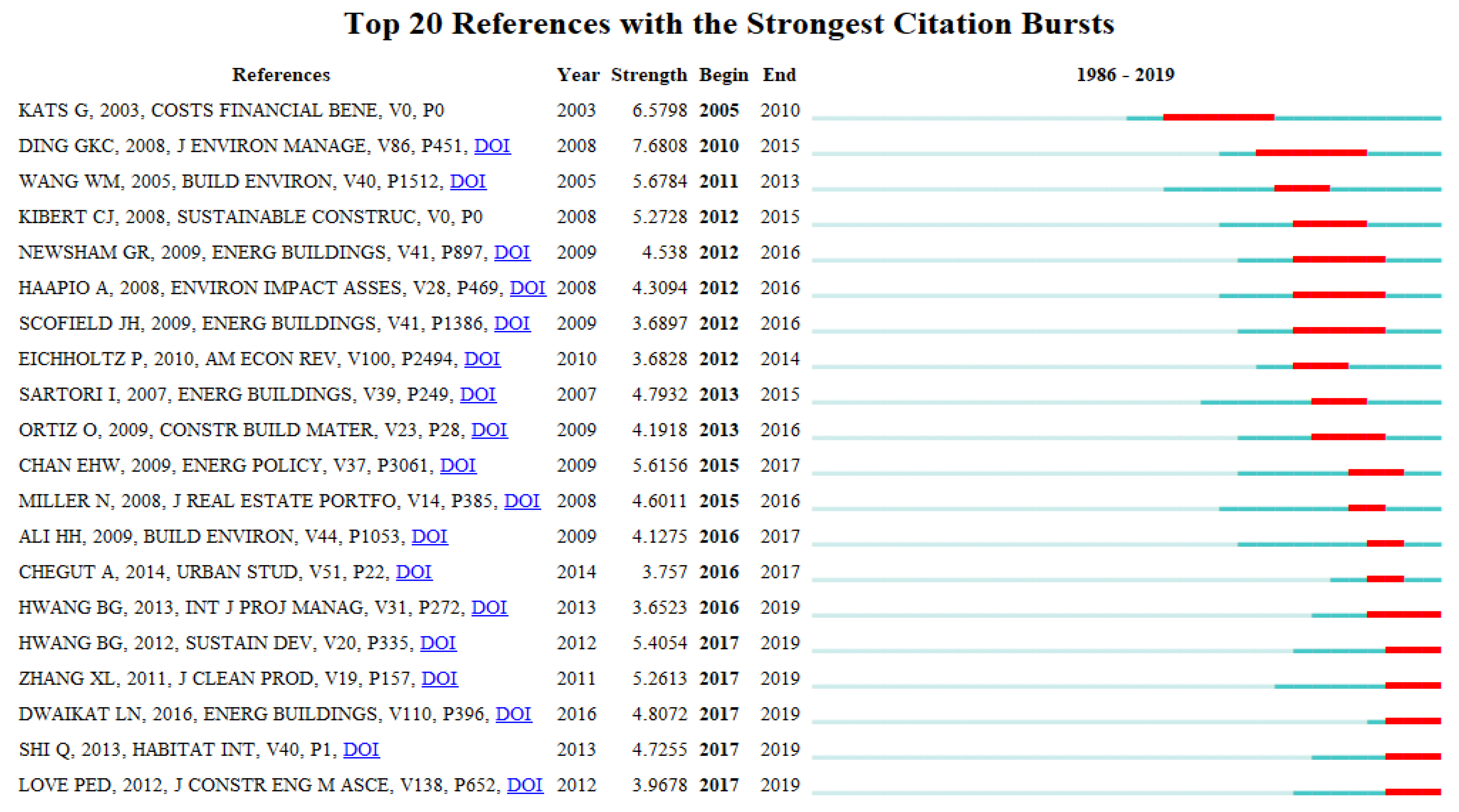
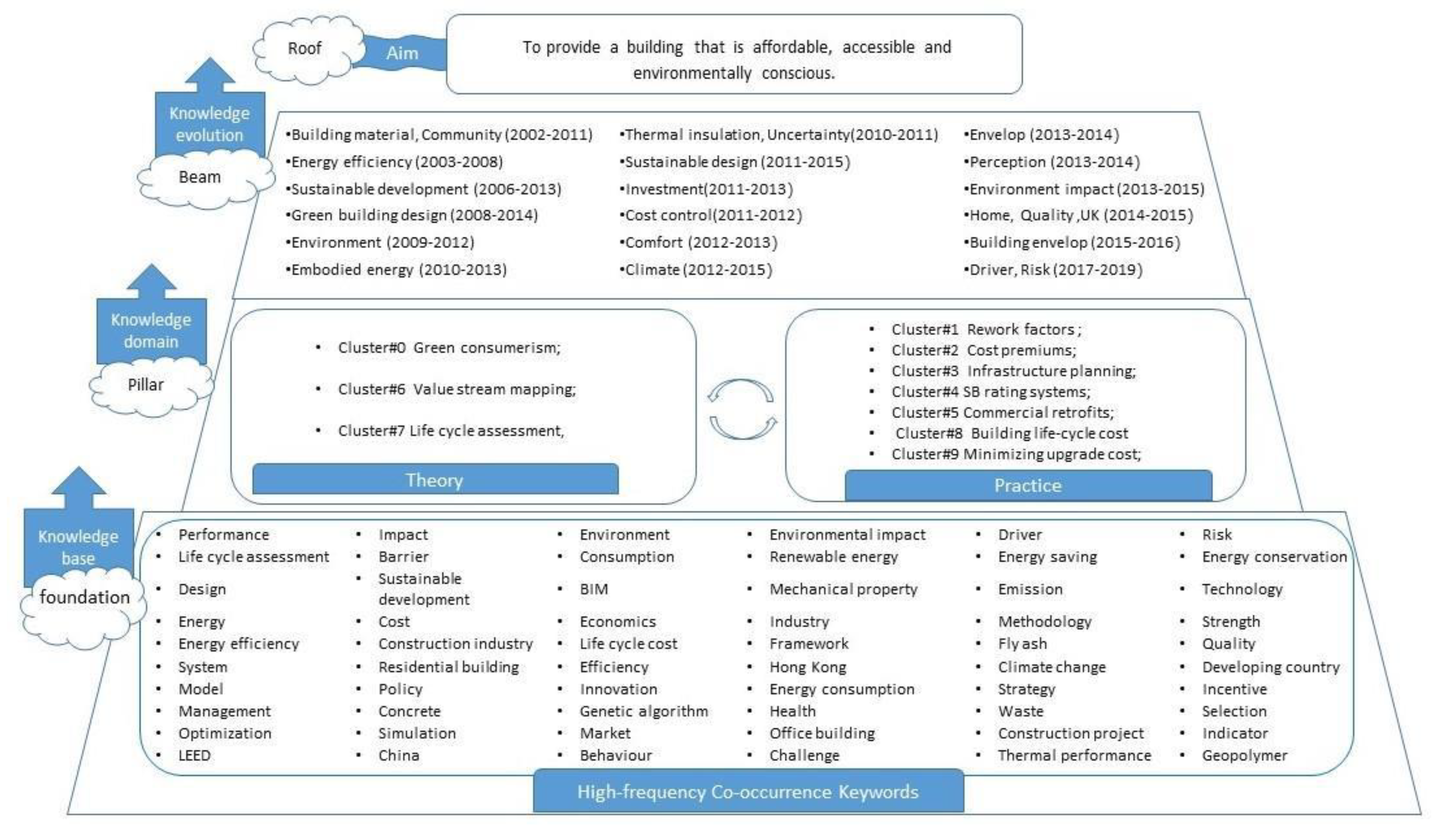
| No. | Author | Title | Source | Year | Cited Frequency |
|---|---|---|---|---|---|
| 1 | J. Zuo; Z. Y. Zhao | Green building research–current status and future agenda: A review | Renewable and Sustainable Energy Reviews | 2014 | 48 |
| 2 | L. B. Robichaud; V. S. Anantatmula | Greening project management practices for sustainable construction | Journal of Management in Engineering | 2011 | 41 |
| 3 | F. Fuerst; P. McAllister | Green noise or green value? measuring the effects of environmental certification on office values | Real Estate Economics | 2011 | 39 |
| 4 | X. L. Zhang; A Platten; LY Shen | Green property development practice in China: costs and barriers | Building and Environment | 2011 | 34 |
| 5 | P. Eichholtz; N. Kok; J. M. Quigley | Doing well by doing good? green office buildings | American Economic Review | 2010 | 34 |
| 6 | P. Eichholtz; N. Kok; J. M. Quigley | The economics of green building | Review of Economics and Statistics | 2013 | 29 |
| 7 | B. G. Hwang; J. S. Tan | Green building project management: obstacles and solutions for sustainable development | Sustainable Development | 2012 | 29 |
| 8 | T. Häkkinen; K. Belloni | Barriers and drivers for sustainable building | Building Research & Information | 2011 | 28 |
| 9 | L. N. Dwaikat; K. N. Ali | Green buildings cost premium: A review of empirical evidence | Energy and Buildings | 2016 | 28 |
| 10 | G. K. C. Ding | Sustainable construction—The role of environmental assessment tools | Journal of Environmental Management | 2008 | 28 |
| Count | Keywords | Count | Keywords | Count | Keywords |
|---|---|---|---|---|---|
| 129 | Performance | 37 | Environment | 19 | Driver |
| 125 | Life cycle assessment | 31 | Consumption | 19 | Energy saving |
| 113 | Design | 30 | BIM | 18 | Emission |
| 111 | Energy | 29 | Economics | 18 | Methodology |
| 108 | Energy efficiency | 28 | Life cycle cost | 17 | Fly ash |
| 86 | System | 27 | Efficiency | 17 | Climate change |
| 78 | Model | 24 | Innovation | 16 | Strategy |
| 71 | Management | 24 | Genetic algorithm | 15 | Waste |
| 69 | Optimization | 24 | Market | 14 | Construction project |
| 64 | LEED | 23 | Behavior | 13 | Thermal performance |
| 62 | Impact | 23 | Environmental impact | 13 | Risk |
| 60 | Barrier | 22 | Renewable energy | 13 | Energy conservation |
| 57 | Sustainable development | 22 | Mechanical property | 13 | Technology |
| 57 | Cost | 21 | Industry | 13 | Strength |
| 46 | Construction industry | 21 | Framework | 12 | Quality |
| 45 | Residential building | 21 | Hong Kong | 11 | Developing country |
| 44 | Policy | 21 | Energy consumption | 11 | Incentive |
| 44 | Concrete | 20 | Health | 11 | Selection |
| 42 | Simulation | 19 | Office building | 11 | Indicator |
| 38 | China | 19 | Challenge | 10 | Geopolymer |
| I1 | Si2 | S3 | M4 | Label (MI) | Label (LSI) | Label (LLR) |
|---|---|---|---|---|---|---|
| 0 | 44 | 0.89 | 2010 | Green consumerism; Decision-making; Tenant | Features; Indoor environmental quality; Criteria | Indoor environmental quality; Energy performance; Residential building property |
| 1 | 38 | 0.82 | 2012 | Rework factors; Rating tools; Green building construction projects | Adoption; GBTs; Construction industry | Purchasing intention; Green housing; Green building |
| 2 | 34 | 0.87 | 2014 | Cost premiums; Delivery methods; Collaboration | GBTs adoption; GBTs; Promotion strategies | GBTs adoption; Promotion strategies; GB development research |
| 3 | 29 | 0.87 | 2008 | Infrastructure planning; Planning and scheduling; Building materials | Knowledge; Developers; Actions | Flooring system; Sustainable building; Construction process |
| 4 | 29 | 0.94 | 2014 | SB rating systems; Environmental aspects; Assessment | Energy simulation; Interoperability; Order | Building information; Sustainable urban-poor housing; SB attribute |
| 5 | 28 | 0.90 | 2008 | Commercial retrofits; Artificial neural network; Multiple regression | Green projects; Preproject planning efforts; Cost performance | Green project; Preproject planning effort; Cost performance |
| 6 | 28 | 0.80 | 2011 | Value stream mapping; Policy and regulations; construction firms practices | GBTs adoption; GBTs; Ghana | Schedule performance; Green building project; Delivering green building project |
| 7 | 27 | 0.91 | 2011 | Life cycle assessment; Sustainable target value; Transaction cost | Adoption; Barriers; Respondents | GB technologies; Promoting GBTs adoption; Target value design |
| 8 | 25 | 0.95 | 2015 | Building life-cycle cost; Sustainable assessment; Green building rating tools | Green buildings; Adoption; Method | Assessment model; Construction industries; Sub- criteria |
| 9 | 25 | 0.94 | 2009 | Minimizing upgrade cost; Life cycle cost; Sustainability of existing buildings | Design element; Building designer; Existing building | Version; Building designers; Credits |
© 2019 by the authors. Licensee MDPI, Basel, Switzerland. This article is an open access article distributed under the terms and conditions of the Creative Commons Attribution (CC BY) license (http://creativecommons.org/licenses/by/4.0/).
Share and Cite
Xiao, X.; Skitmore, M.; Li, H.; Xia, B. Mapping Knowledge in the Economic Areas of Green Building Using Scientometric Analysis. Energies 2019, 12, 3011. https://doi.org/10.3390/en12153011
Xiao X, Skitmore M, Li H, Xia B. Mapping Knowledge in the Economic Areas of Green Building Using Scientometric Analysis. Energies. 2019; 12(15):3011. https://doi.org/10.3390/en12153011
Chicago/Turabian StyleXiao, Xue, Martin Skitmore, Heng Li, and Bo Xia. 2019. "Mapping Knowledge in the Economic Areas of Green Building Using Scientometric Analysis" Energies 12, no. 15: 3011. https://doi.org/10.3390/en12153011
APA StyleXiao, X., Skitmore, M., Li, H., & Xia, B. (2019). Mapping Knowledge in the Economic Areas of Green Building Using Scientometric Analysis. Energies, 12(15), 3011. https://doi.org/10.3390/en12153011







